
Restoring Health-Promoting Soil Biodiversity
We are developing ‘how to’ guidelines to restore urban forest soils for improved health and wellbeing
Our plan
Urban greenspaces are complex ecosystems of plant, animal and microbial life that are largely found belowground. Exposure to soil biodiversity in these greenspaces can promote human and wildlife health by impacting their microbiomes. However, the development of soil biodiversity following aboveground restoration is poorly understood, as are the pathways through which people are exposed to this biodiversity.
We are characterising soil biodiversity from across an urban forest restoration timeline, gauging its development as the aboveground planted forest matures. Network modelling will reveal forest age and soil microbiota associations.
In addition, we are experimentally identifying passive exposure to airborne microbiota to derive an 'aerobiome' exposure metric to the soil microbiota from these forests.
Our research will form ‘how to’ guidelines to restore urban forest soils based on our results.
Trial metagenomics as a method for characterising urban soil microbiota
We are using a shotgun metagenomics approach to optimise methods for characterising soil microbiota in a selection of restored urban forest chronosequence plots.
Profile soil microbiomes, fungi and invertebrates across restoration age gradients
We are characterising soil biota to quantify bacterial, fungal and invertebrate biodiversity from samples taken across the restored urban forest chronosequence. Then Interaction networks will highlight the biotic processes that control how soil biodiversity and the functional potential of resident microbes are affected by time after restoration planting.
Characterise passive exposure to soil microbiota in urban restoration sites
We are using passive sampling to measure airborne microbial biodiversity exposure from air samples collected across the restored urban forest chronosequence. We will derive an 'aerobiome' exposure metric by linking the airborne microbial community with the soil microbe community in each site.
Create guidelines for restoring urban soil biodiversity to promote human and native fauna health
Our results will inform important guidelines for designing aboveground restoration plantings that support biodiverse soil microbiota and aerobiomes important to supplying beneficial microbial exposure for humans and wildlife.






